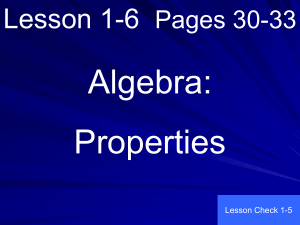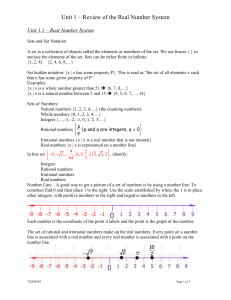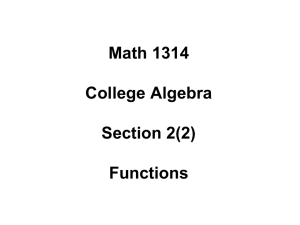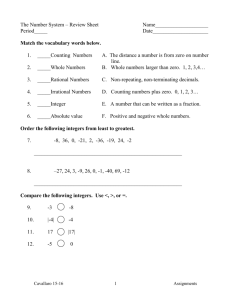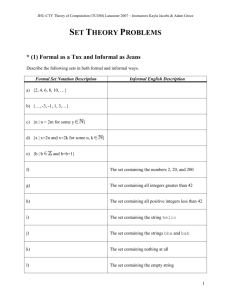Ch 2.2 Adding Real Numbers
advertisement
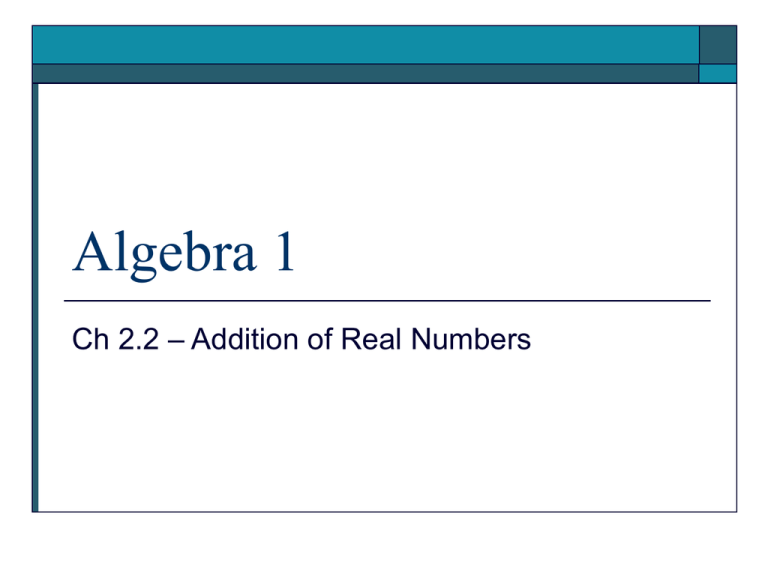
Algebra 1 Ch 2.2 – Addition of Real Numbers Objective Students will add real numbers Before we begin… In this lesson we will look at the rules for adding real numbers Additionally, we will look at 4 properties of addition We will be working with the properties and adding real numbers throughout this course…You will make your life easy if you can master these concepts… Properties of Addition The properties of addition are: Commutative Property Associative Property Identity Property Property of Zero (Inverse Property) You should already be familiar with these properties and may have use them informally in the past…In this lesson we will give them a name and we will look at each one individually… Commutative Property The commutative property states “ The order in which two numbers are added does not change the sum” This property can be expressed as follows: Algebraically: a+b=b+a Example: 3+2=2+3 5=5 Associative Property The associative property states “The way you group three numbers when adding does not change the sum” This property can be expressed as follows: Algebraically: (a + b) + c = a + (b + c) Example: (-5 + 6) + 2 = -5 + (6 + 2) 1 + 2 = -5 + 8 3=3 Identity Property The identity property states: “The sum of a number and zero is that number” This property can be expressed as follows: Algebraically: a+0=a Example: - 4 + 0 = -4 Property of Zero The property of zero is also known as the inverse property. It states: “The sum of a number and its opposite is zero” This property can be expressed as follows: Algebraically: a + (-a) = 0 Example: 5 + (-5) = 0 Adding Real Numbers The rules for adding real numbers are the same as for adding integers… You learned these rules in 6th and 7th grade… In this course you will be expected to know these rules by rote memory… Make no mistake about it….if the sign is wrong the whole problem will be marked wrong…The reason for that is later on in the course you will be transforming and interpreting equations…If you do not master the rules of integers you will not be successful working with equations… Rules for Adding 1. 2. There are a number of ways to add integers…however, the basic two rules are: If the signs are the same you add and keep the sign. If the signs are different you subtract and keep the sign of the larger number Let’s see what they look like… Adding – with the same sign Add: 15 + 25 Since both numbers are positive simply add. The final answer will be positive and look like this: 15 + 25 40 Adding – with the same sign Add: -10 + (-12) Since both numbers are negative simply add. The final answer will be negative and look like this: (-10) + (-12) -22 Adding – with the different signs Add: -10 + 8 The signs of both numbers are different. 10 is negative and 8 is positive. To get you answer subtract 8 from 10 to get 2. Since 10 is the larger number and negative your answer will be negative and look like this: -10 + 8 -2 Adding – with the different signs Add: 12 + (-5) The signs of both numbers are different. 12 is positive and 5 is negative. To get you answer subtract 5 from 12 to get 7. Since 12 is the larger number and positive your answer will be positive and look like this: 12 + (-5) 7 Strategy When working with integers a strategy that you can use to make it easier for you is to chunk the problem… That is…do the numbers first and then evaluate for the signs. Thought Process… When adding integers the thought process that you should be going through is listed below The first question you should be asking your self is “are the signs the same or different?” If you decide that the signs are the same. If you decide that the signs are different. Then add the numbers Then subtract the numbers Your answer will be the same sign as the numbers Figure out what the sign of the larger number is and give that sign to the answer Comments On the next couple of slides are some practice problems…The answers are on the last slide… Do the practice and then check your answers…If you do not get the same answer you must question what you did…go back and problem solve to find the error… If you cannot find the error bring your work to me and I will help… Your Turn Identify the properties 1. -8+0=-8 2 + (-3) = -3 + 2 -2 + 2 = 0 (-4 + 3) + 1 = -4 + (3 + 1) 2. 3. 4. Your Turn Find the sum 5. 17 + 35 = 14 + (-11) = 0 + (-5) = 2 + (-9) + 3 = -4 + 10 + (-6) = 6.8 + 3.3 + (-4.1) = 6. 7. 8. 9. 10. Your Turn Solutions 1. 2. 3. 4. Identity Property Commutative Property Property of Zero Associative Property 5. 6. 7. 8. 9. 10. 52 3 -5 -4 0 6.0 Summary A key tool in making learning effective is being able to summarize what you learned in a lesson in your own words… In this lesson we talked about adding real numbers and the properties of addition… Therefore, in your own words summarize this lesson…be sure to include key concepts that the lesson covered as well as any points that are still not clear to you… I will give you credit for doing this lesson…please see the next slide… Credit I will add 25 points as an assignment grade for you working on this lesson… To receive the full 25 points you must do the following: Have your name, date and period as well a lesson number as a heading. Do each of the your turn problems showing all work Have a 1 paragraph summary of the lesson in your own words Please be advised – I will not give any credit for work submitted: Without a complete heading Without showing work for the your turn problems Without a summary in your own words…
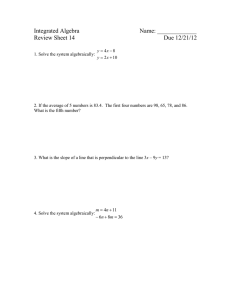
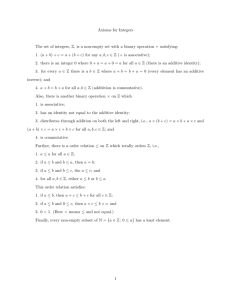


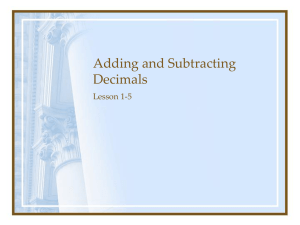
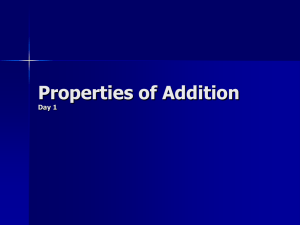
![GRADE 8 MIDTERM - Home [homepage.oceansideschools.org]](http://s3.studylib.net/store/data/005870924_1-cc35afced0304f4b450e5cd8bbcffd4d-300x300.png)
